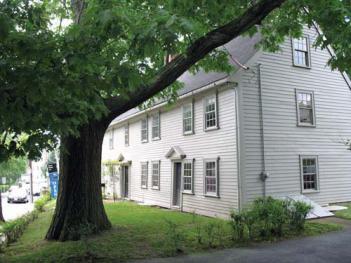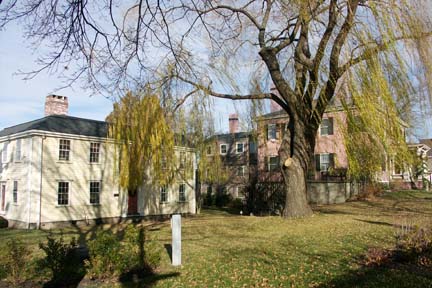August 22, 2013
 The Pierce House on Oakton Avenue, built in 1683, has been open to the public since 1968. Photo courtesy Historic New England
The Pierce House on Oakton Avenue, built in 1683, has been open to the public since 1968. Photo courtesy Historic New England
Dorchester’s Pierce House is a quaint, unassuming structure, nestled in a small lot directly across the street from the Kenny School. A sign on the front walkway is the only indicator of its historical significance.
However, the house’s interior tells a different story. Several rooms are set up as craft and teaching spaces, with one room set up using period furniture, some of which belonged to the Pierce family. Wide slabs of wood are laid across the floor, and thick beams hold up the roof overhead.
“This is all original beaming,” said Ivy Wagner, the Pierce House museum teacher. She explained that most of the original architecture of the house is still in place.
Wagner was a classroom teacher before coming to Pierce House, and she said she loves the working environment, where the teaching material is also the classroom.
“The house is a major primary source. Kids need to know where they came from, and this house is important to the history of Dorchester,” she said. “It’s all hands-on learning, and it fits in exactly with their school curriculum.”
The Pierce House, built in 1683, went through 10 generations of the Pierce family before it was acquired by the Historic New England in 1968. Used mostly as an architecture study, the house had very limited public presence until the early 2000s, when it was refurbished as an educational site for school children.
According to Carolin Collins, educational programs coordinator at Historic New England, several renovations had to be made before the house was declared safe for children. The siding, which was ridden with asbestos, had to be removed, though a small portion of it remains fenced off in the yard for observational purposes. Over the past few years, the Pierce House underwent several weatherization efforts, including the installation of interior storm windows, weather-stripped doors, and a high-efficiency condensing furnace. In addition to these changes, Collins described the ongoing maintenance work that a historic house like Pierce House requires. The paint needs to be kept neat, the furniture should be in good working order, and ceiling damage due to water incursion has to be fixed.
“We try to retain the historic character of the house,” said Collins, explaining that replacements for broken objects or furniture are always from the appropriate time period, or historically accurate replicates. Collins emphasized the importance of using these historic homes for educational purposes, and keeping them open to the public so they can remain an important part of the community.
“Students who live in Dorchester are able to look at the way the area has changed from agrarian to urban. It provides a tangible sense of the area they live in, and it makes history visible,” Collins said. “You can walk by the Pierce House and you wouldn’t know its history, how old it is, or the role its occupants played throughout history.”
Pierce House is just one of several historic landmarks situated in Dorchester and available— at select times— for visits from the public. The Dorchester Historical Society owns and maintains five historic buildings, including the James Blake House on 735 Columbia Rd. Built in 1661, the Blake House is the oldest house in Boston. According to Earl Taylor, president of the DHS, all of the houses have required extensive work during his tenure, which began in 2002.
 Dorchester Historical Society homes: The Lemuel Clap and William Clapp properties on Boston Street. Image courtesy DHS
Dorchester Historical Society homes: The Lemuel Clap and William Clapp properties on Boston Street. Image courtesy DHS
The James Blake House alone has required the replacement of cedar shingle siding on the exterior, the rebuilding of the chimney from the roofline upward, the replacement of wooden gutters, and the replacement of the lead cames on all stained glass windows. Day-to-day upkeep of the historic properties includes scraping, painting, minor wood repairs, and “constant vigilance,” and each of the homes has a live-in caretaker.
Peggy Mullen, a live-in caretaker at the DHS’ Lemuel Clap House, said that living in a historical home is “a singular experience.” She has lived in the house for 23 years, caring for the house’s interior and exterior.
“I’m the eyes and ears for the board,” she said, explaining that she is always careful to report maintenance work that needs to be done on the house. In addition to caring for the house, Mullen considers it her job to “interpret” the house during the monthly tours.
“I ask people who come on tours what they’re interested in learning. It becomes a conversation more than a lecture, and it helps to engage people in the history of the house,” she said, adding that she often learns interesting tidbits about the house and its heritage from descendents who visit or architects and historians. Mullen said that the house has long been an anchor in an especially diverse section of Dorchester that has seen much change over the years.
“[The house] connects us to our past, and it’s important to hold on to that connection,” she said. “It’s a way to begin to talk about subsequent generations and their contributions to history.”
Taylor said that the buildings maintained by the DHS are used for educational purposes, and play host to many different programs. He, too, stressed the value of historic landmarks as primary sources for study.
“Even before the digital revolution, we experienced much of the world through second-hand accounts. Books and photographs are a wonderful means of disseminating information, and the Internet has made information even more widely available,” wrote Taylor in an email. “But seeing artifacts in their physical reality is a different experience. Some of our historic buildings should be preserved so that people now and in the future can experience life as it existed at various times through the past.”
Tours of the DHS properties are given on the third Sunday of each month from 11 a.m. to 4 p.m., and tours of the Pierce House are given three times a year on scheduled dates.



